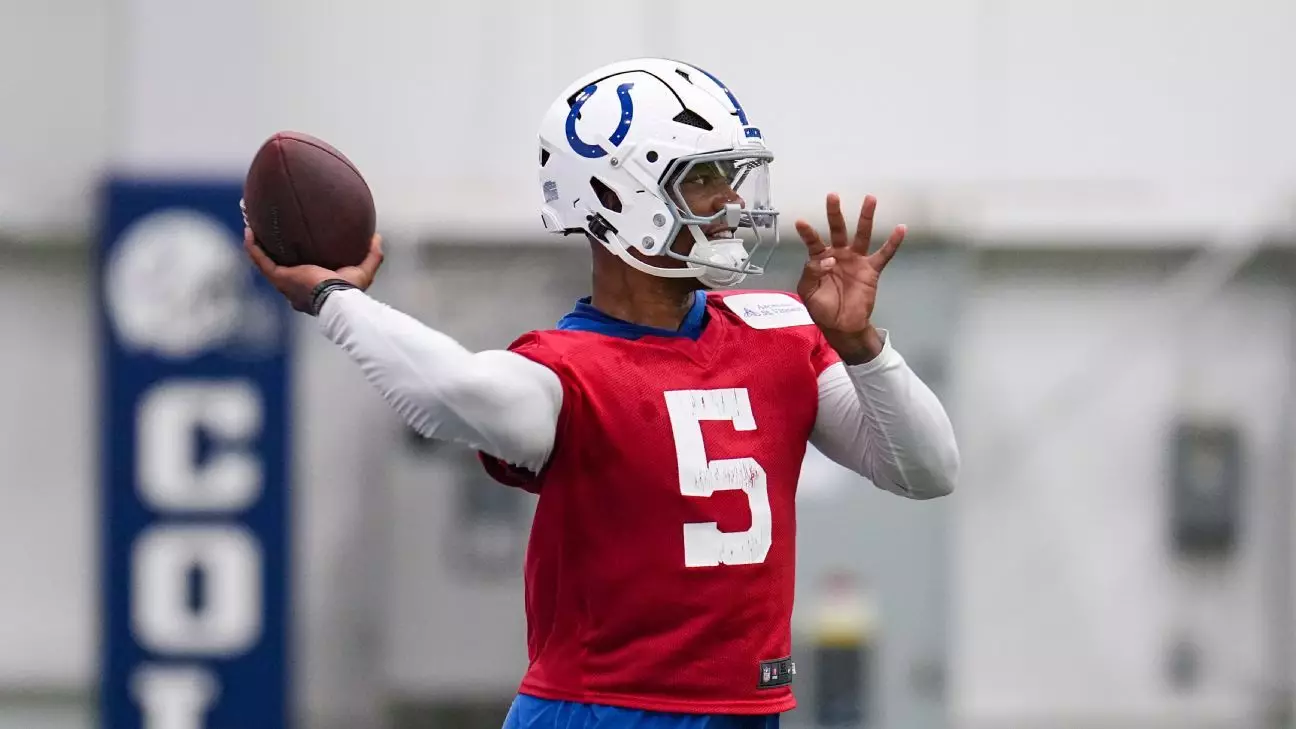In the high-stakes world of professional football, injuries can shift the balance of a team’s performance in an instant. This harsh reality is currently impacting the Indianapolis Colts as their promising young quarterback, Anthony Richardson, finds himself sidelined yet again. Following an aggravation of his previously injured right shoulder joint, Richardson’s potential as the franchise quarterback hangs in the balance. Coach Shane Steichen’s recent confirmation that Richardson will miss critical training sessions has fans and analysts speculating on the long-term ramifications for both the player and the team.
Richardson’s injury narrative is not just a footnote; it underscores a broader issue concerning player durability in a league that demands peak physical performance. The fact that Richardson experienced soreness after a training session and subsequently faced a setback is alarming, especially for a player tasked with steering a franchise that is eager to reclaim its former glory.
The Weight of Expectations
As the fourth overall pick in the 2023 draft, Richardson was heralded as a transformative player who could lead the Colts into a new era. Following the reckoning of past quarterback experiments, the pressure for him to perform well was immense. During his rookie season, injuries marred his development, prompting the Colts to contemplate alternative options, including signing veteran quarterback Daniel Jones. This tactical move, worth a hefty $14 million for one year, not only signified a vote of no-confidence in Richardson’s durability but also highlighted the Colts’ urgent desire for competition at the position.
While the signing of Jones was a strategic attempt to bring depth to a pivotal role, it may also become a double-edged sword. Jones, having faced his own struggles with consistency and performance during his tenure with the New York Giants, could find this moment as an unexpected opportunity. Richardson’s ongoing health issues create a clear path for Jones to demonstrate his worth and potentially revive his NFL career.
The Path Ahead
With Richardson out of commission for an indefinite period, focus will shift to whether he can recover sufficiently in time for training camp, scheduled to start on July 22nd. Steichen’s remarks hint at cautious optimism but underscore the realities of sports injuries. His statement, “when he does come back, we’ll ease him into throwing,” reflects a preventive approach, suggesting that Richardson’s long-term health is a priority over immediate performance.
The Colts have only to look at the past season’s misfortunes to remind themselves of the significant consequences of pushing a player back too soon. Richardson’s absence gives an untested sixth-round rookie, Riley Leonard, an opportunity to prove himself as a reliable No. 2 quarterback. Although Leonard’s presence signals a measure of depth, the team must prepare for the unavoidable bumps inherent in transitioning from the highly drafted quarterback prospect to an unexpected roster slot.
The Broader Implications
Of course, Richardson’s injury is about more than just a position battle; it raises questions about the Colts’ overall strategy moving forward. General manager Chris Ballard’s admission that “we can’t beat our heads against the wall” resonates after Richardson missed 17 games in two seasons due to various ailments. It illustrates a critical challenge that organizations face: cultivating talent while managing the inherent risks tied to player injuries.
With each resilience test Richardson faces, the narrative continues to change, impacting not only his career trajectory but also the Colts’ immediate future ambitions. His struggles magnify a larger theme in professional sports: the intersection of expectations and injury—a dance of sorts that every team must navigate with caution.
Steichen’s cautious approach may indeed serve Richardson and the Colts better in the long run, as they face a delicate balance between developing a young quarterback capable of leading the team and maintaining a competitive edge. It’s a moment rife with both uncertainty and possibility, and how the Colts manage this situation could redefine their future for years to come.

